 This information has been archived for reference or research purposes.
This information has been archived for reference or research purposes.
Archived Content
Information identified as archived on the Web is for reference, research or recordkeeping purposes. It has not been altered or updated after the date of archiving. Web pages that are archived on the Web are not subject to the Government of Canada Web Standards. As per the Communications Policy of the Government of Canada, you can request alternate formats on the "Contact Us" page.
Special Report
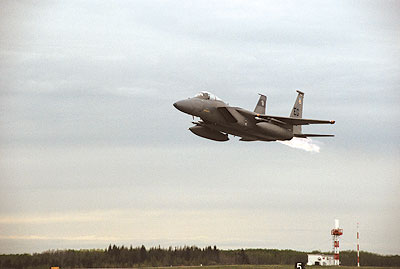
CF photo, 4 Wing, DSC_5708
From The Ground Up: Bringing Exercise Maple Flag Into The 21st Century
by Marcel Duval
For more information on accessing this file, please visit our help page.
Increasing the scope of Maple Flag provides an unprecedented training opportunity for Canada’s Air Force allowing us to maintain interoperability with our allies while demonstrating greater integration of the Canadian Forces within a scenario reflecting today’s unpredictable threat environment.
~ Major-General Charlie Bouchard, OMM, CD, Commander 1 Canadian Air Division/Canadian NORAD Region, 2006
Introduction
For the past 30 years, Canada’s air force has conducted the highly realistic and comprehensive Exercise Maple Flag, which has now evolved into a six-week international advanced air combat exercise held annually at 4 Wing Cold Lake, Alberta. And recently, this prestigious event has changed, helping the air force to contribute significantly to the overall Canadian Forces (CF) transformation effort, while simultaneously providing unparalleled training opportunities for coalition partners.
In late 2005, General Rick Hillier, as Chief of the Defence Staff (CDS), formally announced the beginning of a massive and expedited transformation effort for the Canadian Forces aimed at re-aligning Canada’s armed forces with the operational realities of a post-9/11 world.
“As part of our transformation strategy, the Canadian Forces will better integrate maritime, land, air and special operations forces to allow units to work as one unified team. This will include the creation of new formations. The ultimate goal is to ensure a more relevant, responsive and effective Canadian Forces, capable of operating in the dangerous and complex world of the 21st Century.”1
As part of the process, General Hillier established four Action Teams responsible for Command and Control, Force Generation, Operational Capabilities, and Institutional Alignment. An earlier article of the period, published in Kimberley, British Columbia’s The Daily Bulletin, described the impending transformation initiative as the most comprehensive planned restructuring in four decades. “Gen. Rick Hillier has ordered a transformation that will see control of domestic military assets turned over to integrated regional centers, known as Canada Command.”2
For the air force, this initiative became reality through the appointment of the Commander 1 Canadian Air Division, as the Combined Force Air Component Commander (CFACC), responsible for the Force Employment of Air Resources to joint and combined operations. As such, the assignment of air assets was now to be led solely from the 1 Canadian Air Division Air Operations Centre.
As was also mentioned in the The Daily Bulletin article: “Since the mid-1960s, the Army, Navy and Air Force have worked together to a certain extent. But each section has independent control over ground forces, ships, aircraft and other equipment.”3
Lieutenant-General (ret’d) Steve Lucas, then-Chief of the Air Staff, described air force transformation at the time in the following manner:
“The fundamental principle of central control and decentralized execution of air power has been accepted by the Chief of Defence Staff as the basis on which air power will be delivered to Canada Command, the Canadian Expeditionary Force Command (CEFCOM) and the Canadian Special Operations Force Command (CANSOFCOM). The Commander of 1 Canadian Air Division will become the Combined Forces Air Component Commander (CFACC) for the Commander of Canada Command, responsible for air operations in Canada. In addition, he will retain his responsibilities as the Commander of the Canadian NORAD Region and will continue to report to the Commander of Air Command on force generation issues.”4
Given these conditions, the by-then world-renowned Exercise Maple Flag presented a perfect opportunity to exercise the new structure.

Exercise Maple Flag – Genesis and Background
Maple Flag is a Canadian variation of the United States Air Force’s Exercise Red Flag, which is held several times a year at Nellis Air Force Base, Nevada. Flag exercises were developed in response to a Vietnam War determination that 90 percent of aircraft losses took place during the first 10 combat missions flown by aircrew. Those who survived these critical first 10 missions were deemed more likely to survive the remainder of their combat tours. Maple Flag is one of a number of “Flag-type” events held in a typical exercise year. In addition to several annual iterations of Red Flag, variations have included Green Flag (tactical affiliation with the U.S. Army), Black Flag (aimed at aircraft maintenance), Blue Flag (a planning exercise), and, more recently, the simulation-based Virtual Flag.
The Air Force Tactical Training Centre (AFTTC), located at 4 Wing Cold Lake, directs and hosts Exercise Maple Flag. AFTTC’s fundamental mandate is to provide realistic training to participants in order to simulate the critical lessons presumed to be amassed by operational aircrew during those first 10 combat missions in a hostile environment.
Initially conceived as Red Flag North in 1977, the Canadian version was later renamed Maple Flag in 1978. Two four-week exercises were held each year until 1987. After that time, it became an annual event lasting six weeks, broken into three self-contained, two-week periods. Traditionally, the main focus of the exercise has been directed toward fighter operations and supporting airframes, and it was primarily focused upon the Large Force Employment (LFE) of those entities.
Currently, the exercise simulates a United Nations coalition effort. Although previous Maple Flags have, from year to year, exercised various types of aircraft and missions, it now seeks to wholly encompass all tactical airframes in a modern simulated air combat environment, thus ensuring its relevance to modern threat and tactical scenarios.
Open Skies
4 Wing Cold Lake affords the largest unrestricted airspace in the world, making it a perfect location to simulate a virtually unlimited number of realistic, modern-day scenarios. The wing’s primary asset is the Cold Lake Air Weapons Range (CLAWR), dubbed ‘the world’s largest Hollywood set.’ It covers 1.17 million hectares (11,600 square kilometres), and it is the only tactical bombing range in Canada. Vast, unrestricted airspace with no impinging civilian air traffic, coupled with more than 640 tactical targets, ensure that the range continues to be a dynamic and realistic training environment.
The Exercise Maple Flag scenario is superimposed upon a healthy portion of the geography of both Alberta and Saskatchewan, and it is loosely based upon a compilation of past and current events applicable to the Middle East. Scenarios become increasingly more complex with each successive day of a given exercise. Allied Forces (AFOR), acting as Blue Air, are deployed to provide conventional ground attack, air superiority, tactical re-supply, reconnaissance, Airborne Early Warning and Control (AWACS), and air-to-air refuelling. Opposing Forces (OPFOR), acting as Red Air, provide the air and ground threats. Maple Flag generates two launch waves on each exercise day of a simulated 10-day air campaign.
Targets are built to resemble tanks, missile launchers, radar sites, industrial sites, command and control centres, and various types of vehicles and aircraft. Among the 100 target complexes within the CLAWR are seven mock airfields that simulate complete facilities including runways, ramps, taxiways, and dispersal areas. Buildings and three-quarter scale airframes and vehicles also add to the realism and training efficiency of these mock airfields.
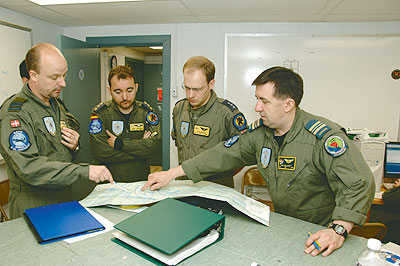
CF photo FA 2006-0250a
Mission planning.
Daily Flow Plan
During the exercise period, weather permitting, twice a day, morning and afternoon, 4 Wing simultaneously launches dozens of aircraft: fighter, rotary, and transport, into the designated training area.
The Daily Flow Plan begins with a morning mission mass briefing of the designated AFOR, given by the Package Commander. The designated Package Commander and the designated Mission Monitor will have previously coordinated a chronological morning Mission Flight Plan prior to the mass briefing. Maps, meteorological services, flight-planning services, computer-assisted mission planning tools, computer-assisted briefing tools, and data-entry personnel are always available to assist in this planning.
The Package Commander has a number of responsibilities, including the need to demonstrate positive target de-confliction, and, most importantly, to always bear in mind that the plan must be catered to a junior wingman’s level. The OPFOR Brief is provided simultaneously to the AFOR brief, and it is given by the Mission Monitor, who acts on behalf of the Officer Commanding AFTTC to oversee all aspects of the mission, including the flight safety briefing.
The Fight’s On!
Throughout the exercise period, Blue forces conduct numerous missions within the overall exercise package, ranging from Offensive Counter Air (OCA), more commonly known as Air-to-Air, Strike (air-to-ground attack), and the Suppression of Enemy Air Defences (SEAD). A Surface Threat Electronic Warfare (STEW) system targets aircraft from the ground, while Red Air, which is composed predominantly of Aggressor squadrons from Nellis Air Force Base in Nevada, and Canada’s Top Aces, the exclusive suppliers of Combat Support services for the Canadian Forces, engage Blue Air assets in flight. AWACS platforms play a critical role by acting as air battle managers for Combat Air Operations (CAOs). They are responsible for optimizing air routes, for orchestrating the defence of high-value airborne assets, for coordinating routes designated for air-to-air refuelling, for managing data-links, for providing early warning for activation of airborne surface threats using passive detection sensors, and for ensuring flight safety remains paramount by providing fighter control for AFOR assets. 42 Radar Squadron provides Ground Control Intercept (GCI), and, as such, control of Red Air assets is the squadron’s primary exercise responsibility. However, it also has an area of overlapping responsibilities with AWACS, whereby it takes control of Blue Air resources at any time the AWACS becomes unavailable. Transport aircraft also have a role to play, by conducting parachute drops and inserting Special Forces. Each mission lasts for just over an hour, and then the participating aircraft return to home base for a mass debriefing. Make no mistake. Maple Flag is not a competition. There are no winners or losers per se. However, only through the medium of the extensive and thorough debriefing process will the participants officially find out who succeeded on a particular mission, and who did not, and, traditionally, many of the engagements have been ‘won or lost’ in the debriefing rooms...
Debriefing
After a typical mission, the debriefing is held in the AFTTC Main Theatre, a truly ‘cutting-edge’ briefing facility. It is the technological hub for the debriefing, permitting the simultaneous display of STEW inputs, Air Combat Manoeuvring Instrumentation (ACMI) results, and Heads-Up Display (HUD) video and recordings. The spacious, 250-seat, three-screen theatre provides aircrew with the ability to make state-of-the-art audio/visual presentations. In all, aircrew can analyze missions thoroughly and effectively, and can discuss the all-important lessons learned, thus maximizing the training benefit derived from the missions conducted.
Independent Observer’s Program (IOP)
The IOP program is a relatively new initiative at Exercise Maple Flag. It affords an opportunity for units from all over the world to see first hand what is transpiring during an exercise, and it often serves as a precursor to actual exercise participation. These observers are assigned to experienced Maple Flag staff members, who serve as escorts for several days throughout the exercise period of the observer’s choice. To date, the IOP has hosted contingents from Spain, Chile, Brazil, Greece, and India, along with representatives from many other nations.
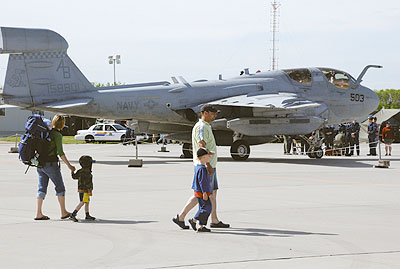
CF photo, 4 Wing, DSC_5948
Many sophisticated Electronic Warfare (EW) assets now participate in Exercise Maple Flag, such as this Northrop Grumman EA-6 Prowler.
Exercise Evolution and Innovation
Training international coalitions solely for the purpose of aerial ‘dog-fighting’ has become an obsolete approach to combat effectiveness. Today’s threat environment is much more complex, and it requires training in a multidimensional environment. This underscores the need for a unified approach to training, and joint and coalition operations have become the main watchwords by which we now train and operate. Accordingly, 2005 marked a significant turning point for Maple Flag from the perspective of being a traditionally European-oriented NATO exercise. For the first time, MF 38 included 10 Israeli F-16s among approximately 200 aircraft from participating NATO countries. In his article, A New Kind of War, author Jon Elmer described the controversial move as having signalled a marked shift in Canadian military and political policy: in short, ‘more Gaza, less Battle of Britain.’5
In 2006, with the entire Canadian Forces caught up in the middle of a massive transformation effort, Major-General [now Lieutenant-General] Charlie Bouchard, Commander of 1 Canadian Air Division and the Canadian NORAD Region, significantly overhauled Exercise Maple Flag, ensuring its relevance to the modern combat environment. At MF 39, for the first time, CP-140 Aurora, CC-130 Hercules, and CH-146 Griffon aircraft, as well as land forces, were incorporated into the exercise scenarios, while the 1 Canadian Air Division Air Operations Centre was exercised simultaneously under the umbrella of central control and decentralized execution. Additionally, this particular iteration of Maple Flag marked the establishment of Camp Medley at 4 Wing Cold Lake, a 300-person temporary support camp used to exercise the new Mission Support Readiness initiative – further demonstrating and validating the required expeditionary capabilities of today’s air force. The 17 Wing (Winnipeg) Mission Support Squadron (MSS) was the first to exercise at Camp Medley, but MSSs drawn from across the air force establishment would soon follow suit. The CP-140 Aurora, which traditionally has been used as a long-range patrol aircraft in support of maritime operations, has also been acknowledged for its value as an over-land asset. CP-140 Aurora aircraft and CH-146 Griffon helicopters participating in Maple Flag were retrofitted with electro-optic/infrared (EO/IR) sensors, allowing them to carry out an overland surveillance role, a stepping stone toward Dynamic Targeting (DT) for use in future Maple Flags. In fact, the integration of Special Operations forces from Germany and Canada facilitated combined DT missions at the Canadian Manoeuvre Training Centre in Wainwright. Forces were inserted by using a combination of 417 Squadron’s CH-146 Griffons and transport aircraft from Germany, France, New Zealand, the United States and Canada. Additionally during this exercise, Close Air Support (CAS) missions were conducted by Belgian, Dutch, French, American, and Canadian fighter aircraft.
AFTTC staff also undertook multiple initiatives for the MF 40 exercise in 2007. Specifically, Maple Flag was further advanced by the implementation of multiple command, control, and communication (C3) airframes, and by the incorporation of the Canadian Manoeuvre Training Centre (CMTC) Wainwright, Dynamic Targeting, and Joint Tactical Air Control (JTAC) teams into the exercise scenario. Partnership for Peace country participation also premiered during this particular iteration of the exercise. And Maple Flag has further expanded the vision of bringing the exercise into the 21st Century through the recent addition of Ground-based Air Defence Systems, also known as man-portable air defence systems threat (MANPADS.) This is significant, since at the 2003 Asia-Pacific Economic Cooperation forum, former U.S. Secretary of State Colin Powell had warned, “[that] no threat is more serious to aviation” than MANPADS.6 These weapons, employed daily by insurgent groups, are easy to use and are readily available on the black market, and, as such, they pose an imminent threat to military aircraft and civilian airliners. Divided into three-man ‘Stinger teams,’ the 11th Air Assault Brigade from Schaarsbergen, Holland, deployed a platoon of soldiers to Maple Flag 40. These ground-based air-defence assets were equipped with the portable Stinger missile, and were directed to target enemy aircraft. “Their role is to take up a brigade and fly them in by helicopter. They go in behind enemy lines,” explained Dutch Warrant Officer Ivor Sam-Sin, who was responsible for operations and training with the unit. The presence of MANPADS at Maple Flag not only made available invaluable training for the aircrew participants, but it also provided a unique opportunity for the Dutch unit to train at both the CLAWR and CMTC Wainwright facilities. “Because of built-up areas, cities and no low-flying areas [in Holland], we have to go abroad for training,” adds Sam-Sin. “That’s the reason we come to Maple Flag every year. There are not many exercises that offer so much space and live targeting.”

CF photo, 4 Wing, DSC_5323
Solders and Transall transport aircraft
The Evolution of Maple Flag Technology
The technology available to participants at Maple Flag is second-to-none. The high technology systems resident at 4 Wing enable the CF to provide high quality aircrew training to support NATO and peacekeeping operations. They also ensure that both participants and Canada’s military are adequately prepared for the challenges that lie ahead. The CLAWR is a world-class range possessing the ability to simulate a multitude of ‘real world’ targets and ground-based threat systems.
- Tactical Range Infrared Scoring System (TRISS)
Falling within the CLAWR, Jimmy Lake Range (JLR) is equipped with TRISS–four infrared cameras that provide day and night laser scoring capability. - Infrared/Radio Frequency (IR/RF) Targeting
Wooden targets, designed in the 1960s, worked well when fighter pilots were flying at low level and could visually locate them. However, during the late 1990s, the CF changed its flying doctrine, mandating medium-level attacks for CF-18 Hornet aircraft. In this environment, pilots are employing precision-guided munitions requiring sensory feedback. They are no longer dependent upon the visual acquisition of targets. Year 2007 enhancements with respect to infra-red (IR) reflective tape and metal meshing generated improved participant targeting ability by increasing surface target radar and IR reflectivity to more accurate levels. - Aircraft Combat Manoeuvring Instrumentation (ACMI)
The ACMI is a pod carried on the wingtip of fighter aircraft that tracks the aircraft from take-off to landing. It provides speed, azimuth, the number of ‘Gs’ pulled, the angle of attack, and additional information. The Data Transfer Device (DTD) is the ‘brains’ of the operation. Fundamentally, it is a programmable cartridge that records the mission. Additionally, a GPS tracking capability provided by Cubic Systems was recently improved. In 2007, it incorporated airframes that previously were unable to be tracked in detail for debriefing purposes. Prior to the advent of ACMI, debriefs were based upon results garnered from 8mm tapes, and debates were initiated from acetate slides. ACMI provided ‘real-time’ air-to-air experiences integrated with surface threats that were then recorded for post-mission debriefs. - Surface Threat Electronic Warfare (STEW)
The $14 million STEW project provides a fully integrated system, based upon production hardware that meets the CF’s requirements for year-round operations at the CLAWR. The system is integrated with the ACMI system for CF-18 training, and it is a proven, low risk and cost-effective solution to the Electronic Warfare (EW) training needs of the CF. The system is made up of five threat emitters that can be reconfigured to replicate a range of threat systems. It is responsive to jamming and manoeuvres, and it automatically records an engagement for later playback and aircrew debriefing. This training enhances the ability of aircrew to survive during warfare against the wide array of lethal gun and missile air defence systems that are employed worldwide. - Satellite Videos
Ground threats actively target fighter and transport aircraft, and the results are taped on video. Until 2007, 417 Combat Support Squadron’s CH-146 Griffons were used to conduct ‘tape runs,’ whereby they would collect the tapes from each site and return them to AFTTC for the debriefing. Thereafter, a cost-saving and time-saving digital transfer initiative was implemented, resulting in significant savings to the CF for each exercise. - OPFOR Initiatives
MF 40 marked the first-time participation of the 65th Aggressor Squadron from Nellis Air Force Base, flying the F-15 Eagle. Previous participation had consisted of the 64th Aggressor Squadron, employing F-16 Vipers. This change provided a different flavour to the problems faced by Allied Forces participating in the exercise. - Operations and Planning Facilities Modernization
The Tactical Command Centre (TCC) and Package Commander facilities were revitalized for MF 40 with the addition of custom-built computer terminals, mission planning tables, and GPS clocks. An older trailer was completely revamped for the dedicated use of Information Systems.
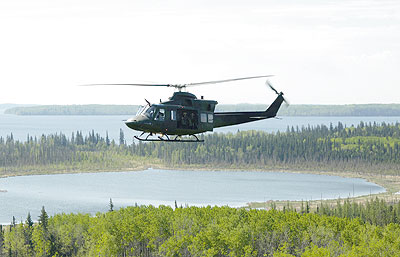
CF Combat Camera image IS2006-1112a by Sgt Roxanne Clowe
Maple Flag has evolved into a much stronger rotary-wing presence, exemplified here by a CH-146 Griffon helicopter flying over the Cold Lake training area.
The future of Maple Flag: Evolution and Challenges
While MF has evolved in leaps and bounds over the last few years, it still has a long way to go. The exercise will continue to evolve as long as the nature of conflict itself is evolving. General Bouchard often stated, tongue-in-cheek, that if he could figure out a way to bring a ship to land-locked Cold Lake, he would do so. While the prospect of this occurring is highly unlikely, the rapidity of technological evolution with respect to virtual systems clearly demonstrates that even such complete integrations may be just a few steps away. And as easy as it is to become engulfed in a present state of world affairs, it is equally important not to lose perspective and the need to plan for future combat scenarios, since today’s war may not be tomorrow’s war.
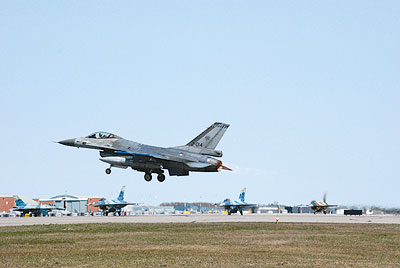
DND photo 4 Wing DSC_5136
A Dutch F-16 on take-off.
Behind the Scenes: People First
At its peak to date, Exercise Maple Flag has hosted 2000 visitors and up to 150 aircraft for each exercise period. Participating aircraft have included fighters, transports, tankers, AWACS, and SEAD/Electronic Warfare (EW) assets, employed in launches of 90 to 95 aircraft for each mission. At times, the daily flow rate was up to 110 aircraft participating in each launch – no small feat for the detachment’s support personnel.
No military exercise is complete without logistical support. In addition to the support from participating units, 4 Wing hosts many personnel who come from units all across Canada to lend a helping hand. A team of 15 augments the established eight year-round staff dedicated to Maple Flag in order to ensure that the framework is functional for all participants. While many participants are requested through the Canadian Forces Task and Planning Orders (CFTPO), many augmentees for MF 40 voluntarily joined the small permanent staff from all over Canada. And from the exercise director’s point of view, augmentees have proven critical to the success of the exercise.
Conclusion
It is now a full 30 years since exercise inception, and Exercise Maple Flag, and the staff who run it at the Air Force Tactical Training Centre continue to receive many accolades for continuing tactical significance in the 21st Century. In an era where all coalition countries are ‘task saturated,’ AFTTC and Exercise Maple Flag remain highly relevant, and they are touted as a premier Canadian venue that offers all the critical exposure required for operational aircrew prior to their becoming engaged in combat operations.
Clearly, new and exciting changes confronting the air force increase the involvement of ground components of the Canadian Forces and other nations. Canada has, as noted by General Bouchard, “...changed the vectors of Maple Flag to move it towards greater integration across the air force, and, indeed, the Canadian Forces.” Notwithstanding, Exercise Maple Flag remains dedicated to providing unsurpassed facilities to foster the ability to train an Air Expeditionary Force (AEF). Ongoing improvements are addressing joint interoperability specifically with other CF environments and coalition partners. Joint participation precipitates joint feedback. Again, according to General Hillier, there is no time like the present to be capitalizing upon experience .levels in order to maximize training value.
“From private to general, the current generation of the Canadian Forces possesses more operational experience than at any time in decades. We will use that experience to fundamentally transform the military’s shape and structure so we can perform our mission with the utmost efficiency.”7
In closing, Lieutenant-General Lucas summarized the current state of the Air Force:
“While there are still many changes ahead of us, we have overcome many of the toughest challenges so far and are well positioned to ensure that Canada’s Air Force will be even more relevant, responsive and effective as it becomes more integrated with other elements of the CF.”8
![]()
Major-General J.M. Duval, CMM, CD, a highly experienced tactical helicopter pilot, is currently Commander 1 Canadian Air Division and the Canadian NORAD Region.
Notes
- General Rick Hillier, Editorial, The Hill Times, 26 September 2005, Issue 806, p. 24.
- Terry Pedwell, “Military Begins Major Overhaul to Speed up Response to Disasters, Terrorism,” in The Daily Bulletin, 6 June 2005, p. 12.
- Ibid.
- Lieutenant-General Steve Lucas, Commentary, NATO’s Nations and Partners for Peace, Issue 3, (Bonn: Mönch Publishing Group, 2005), p. 64.
- Jon Elmer, “A New Kind of War,” in This, Vol. 39, No. 2, September/October 2005, p. 11.
- Dirk Beveridge, “APEC Nations Agree to Limit Missile Sales,” from Associated Press, 18 October 2003.
- General Rick Hillier, p. 24.
- Lieutenant-General Lucas, p. 64.
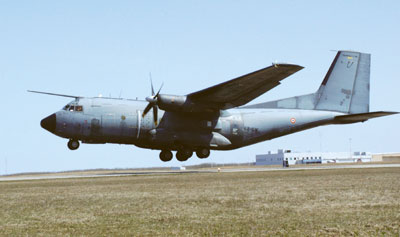
DND photo 4 Wing DSC_5116






